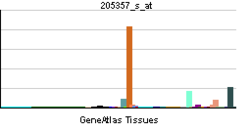AGTR1
| edit |
AGTR1 (Angiotenzinski II receptor, tip 1, AT1 receptor) je angiotenzinski receptor. On ima simpatomimetičko dejstvo i reguliše sekreciju aldosterona. On je značajan efektor kontrole krvnog pritiska i zapremine u kardiovaskularnom sistemu. Antagonisti angiotenzin II receptora su lekovi za hipertenziju, dijabetesnu nefropatiju i srčanu insuficijenciju. AGTR1 je najbolje istraženi angiotenzinski receptor.
Angiotenzinski receptori se aktiviraju vazokonstriktivnim peptidom angiotenzin II. Aktivirani receptor se spreže sa Gq/11, aktivira fosfolipazu C i povišava koncentraciju citosolnog Ca2+, čime se zatim inicira ćelijski respons kao što je stimulacija proteinske kinaze C. Aktivirani receptor takođe inhibira adenilat ciklazu i razne tirozinske kinaze.[1]
- ↑ Higuchi S, Ohtsu H, Suzuki H, Shirai H, Frank GD, Eguchi S (2007). „Angiotensin II signal transduction through the AT1 receptor: novel insights into mechanisms and pathophysiology”. Clin. Sci. 112 (8): 417–28. DOI:10.1042/CS20060342. PMID 17346243.
- Matsusaka T, Ichikawa I (1997). „Biological functions of angiotensin and its receptors.”. Annu. Rev. Physiol. 59: 395–412. DOI:10.1146/annurev.physiol.59.1.395. PMID 9074770.
- Allen AM, Moeller I, Jenkins TA, et al. (1998). „Angiotensin receptors in the nervous system.”. Brain Res. Bull. 47 (1): 17–28. DOI:10.1016/S0361-9230(98)00039-2. PMID 9766385.
- Berry C, Touyz R, Dominiczak AF, et al. (2002). „Angiotensin receptors: signaling, vascular pathophysiology, and interactions with ceramide.”. Am. J. Physiol. Heart Circ. Physiol. 281 (6): H2337–65. PMID 11709400.
- Arima S, Ito S (2001). „New insights into actions of the renin-angiotensin system in the kidney: concentrating on the Ang II receptors and the newly described Ang-(1-7) and its receptor.”. Semin. Nephrol. 21 (6): 535–43. DOI:10.1053/snep.2001.26792. PMID 11709801.
- Stowasser M, Gunasekera TG, Gordon RD (2002). „Familial varieties of primary aldosteronism.”. Clin. Exp. Pharmacol. Physiol. 28 (12): 1087–90. DOI:10.1046/j.1440-1681.2001.03574.x. PMID 11903322.
- Padmanabhan N, Padmanabhan S, Connell JM (2002). „Genetic basis of cardiovascular disease--the renin-angiotensin-aldosterone system as a paradigm.”. Journal of the renin-angiotensin-aldosterone system : JRAAS 1 (4): 316–24. DOI:10.3317/jraas.2000.060. PMID 11967817.
- Thibonnier M, Coles P, Thibonnier A, Shoham M (2002). „Molecular pharmacology and modeling of vasopressin receptors.”. Prog. Brain Res. 139: 179–96. DOI:10.1016/S0079-6123(02)39016-2. PMID 12436935.
- Elton TS, Martin MM (2003). „Alternative splicing: a novel mechanism to fine-tune the expression and function of the human AT1 receptor.”. Trends Endocrinol. Metab. 14 (2): 66–71. DOI:10.1016/S1043-2760(02)00038-3. PMID 12591176.
- Saavedra JM, Benicky J, Zhou J (2007). „Mechanisms of the Anti-Ischemic Effect of Angiotensin II AT( 1 ) Receptor Antagonists in the Brain.”. Cell. Mol. Neurobiol. 26 (7-8): 1099–111. DOI:10.1007/s10571-006-9009-0. PMID 16636899.
- Oliveira L, Costa-Neto CM, Nakaie CR, et al. (2007). „The angiotensin II AT1 receptor structure-activity correlations in the light of rhodopsin structure.”. Physiol. Rev. 87 (2): 565–92. DOI:10.1152/physrev.00040.2005. PMID 17429042.
- Ariza AC, Bobadilla NA, Halhali A (2007). „[Endothelin 1 and angiotensin II in preeeclampsia]”. Rev. Invest. Clin. 59 (1): 48–56. PMID 17569300.
- Xia Y, Zhou CC, Ramin SM, Kellems RE (2007). „Angiotensin receptors, autoimmunity, and preeclampsia.”. J. Immunol. 179 (6): 3391–5. PMID 17785770.
- Mauzy CA, Hwang O, Egloff AM, et al. (1992). „Cloning, expression, and characterization of a gene encoding the human angiotensin II type 1A receptor.”. Biochem. Biophys. Res. Commun. 186 (1): 277–84. DOI:10.1016/S0006-291X(05)80804-6. PMID 1378723.
- Curnow KM, Pascoe L, White PC (1992). „Genetic analysis of the human type-1 angiotensin II receptor.”. Mol. Endocrinol. 6 (7): 1113–8. DOI:10.1210/me.6.7.1113. PMID 1508224.
- Furuta H, Guo DF, Inagami T (1992). „Molecular cloning and sequencing of the gene encoding human angiotensin II type 1 receptor.”. Biochem. Biophys. Res. Commun. 183 (1): 8–13. DOI:10.1016/0006-291X(92)91600-U. PMID 1543512.
- Takayanagi R, Ohnaka K, Sakai Y, et al. (1992). „Molecular cloning, sequence analysis and expression of a cDNA encoding human type-1 angiotensin II receptor.”. Biochem. Biophys. Res. Commun. 183 (2): 910–6. DOI:10.1016/0006-291X(92)90570-B. PMID 1550596.
- Bergsma DJ, Ellis C, Kumar C, et al. (1992). „Cloning and characterization of a human angiotensin II type 1 receptor.”. Biochem. Biophys. Res. Commun. 183 (3): 989–95. DOI:10.1016/S0006-291X(05)80288-8. PMID 1567413.
- Gemmill RM, Drabkin HA (1992). „Report of the Second International Workshop on Human Chromosome 3 mapping.”. Cytogenet. Cell Genet. 57 (4): 162–6. PMID 1683828.
- Curnow KM, Pascoe L, Davies E, et al. (1996). „Alternatively spliced human type 1 angiotensin II receptor mRNAs are translated at different efficiencies and encode two receptor isoforms.”. Mol. Endocrinol. 9 (9): 1250–62. DOI:10.1210/me.9.9.1250. PMID 7491117.
- Marrero MB, Schieffer B, Paxton WG, et al. (1995). „Direct stimulation of Jak/STAT pathway by the angiotensin II AT1 receptor.”. Nature 375 (6528): 247–50. DOI:10.1038/375247a0. PMID 7746328.
- „Angiotensin Receptors: AT1”. IUPHAR Database of Receptors and Ion Channels. International Union of Basic and Clinical Pharmacology. Arhivirano iz originala na datum 2014-02-28.


